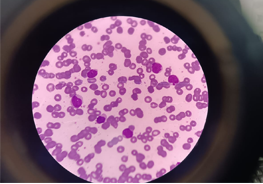Best Hospital for Leukemia Treatment in Delhi
Leukemia, commonly known as blood cancer is a type of cancer that affects the blood-forming cells of the body, such as the bone marrow. It is the most common cancer in children and has an excellent outcome if treated at the right time with right treatment.
There are various types of leukemia depending on the type of blood cells involved. It can be acute or chronic type, acute leukemias are more common in children. Certain types of Leukemia like ALL (Acute lymphoblastic leukemia) is more common in children than adults. Leukemia usually affects white blood cells. In leukemia , the bone marrow produces an abnormally large number of abnormal white blood cells which are immature in nature.

Symptoms
The following are common signs and symptoms:
- Prolonged fever for more than 2-3 weeks, where the cause of fever is not found
- Fatigue and weakness that persists, child will look pale
- Swollen lymph nodes, enlarged liver or spleen
- Easy bruising or bleeding, black spots in the body or rashes in the body
- Bone pain or joint pain
- Headache and vomiting if leukemic cells spread to the brain
Cause
Leukemia is thought to develop when some blood cells' genetic material, or DNA, undergoes changes (genetic mutations). When this happens, the production of blood cells becomes uncontrollable. These abnormal cells start occupying the bone marrow space resulting in fewer healthy white blood cells, red blood cells, and platelets.
How is leukemia classified?
Leukemia is classified based on its rate of progression and the type of cells involved.
The first classification is based on how quickly leukemia progresses:
Acute Leukemia: In acute leukemia, abnormal blood cells are immature blood cells (blasts). They are unable to carry out their normal functions and multiply rapidly, causing the disease to worsen rapidly. Acute leukemia necessitates prompt and aggressive treatment.
Chronic Leukemia: More mature blood cells are involved in chronic leukemia. These blood cells replicate or accumulate at a slower rate and can function normally for some time. Some types of chronic leukemia have no early symptoms and can go undetected or undiagnosed for years. This type of leukemia is more common in adults.
The second classification is determined by the type of white blood cell that is affected:
Lymphocytic leukemia (LL). This type of leukemia affects lymphoid cells (lymphocytes), which are responsible for the formation of lymphoid or lymphatic tissue Lymphatic tissue makes up your immune system.
Myelogenousleukemia myeloid cells are affected by this type of leukemia.
Leukemia Types
- Acute lymphoblasticleukemia (ALL). This is the most common type of leukemia in children between 2-10 years of age. ALL can affect adults as well.
- Acute myeloid leukemia (AML). AML affects both children and adults, but more common in adults.
- Chronic lymphocytic Leukenia (CLL). Seen in adults only
- Chronic myeloid leukemia (CML). This type of leukemia more commonly affects adults but small number of older children can also be affected by this type.
- Other kinds. Hairy cell leukemia, myelodysplastic syndromes, and myeloproliferative disorders are examples of rarer types of leukemia.
Risk elements
Some risk factors for developing certain types of leukemia include:
- Previous cancer therapy. People who have received certain types of chemotherapy and radiation therapy for other cancers are more likely to develop certain types of leukemia.
- Genetic conditions. Genetic abnormalities appear to play a role in leukemia development. Certain genetic conditions, such as Down syndrome, have been linked to an increased risk of leukemia.
- Certain chemical exposure. Exposure to certain chemicals, such as benzene (found in gasoline and used in the chemical industry), has been linked to an increased risk of certain types of leukemia.
- Smoking increases the risk of acute myelogenousleukemia. Passive smoking is more dangerous; it can lead to genetic mutation in the foetus in utero.
Diagnosis
If leukemia is suspected based on any signs or symptoms ,then the child is advised to do the , following diagnostic tests:
- Physical examination. Physical signs of leukemia include pale skin from anemia, swelling of your lymph nodes, and enlargement of your liver and spleen.
- Blood tests are performed: Complete blood count and Peripheral smear are the two most important tests which gives lot of information about the diagnosis.
- Bone marrow examination. Bone marrow examination is the confirmatory test for diagnosis of leukemia and also to find out the type of leukemia bone marrow examination is a must. For the bone marrow examination test, child is given mild sedation and bone marrow sample is extracted by a needle from the hipbone. It is a simple bed side procedure. The collected sample is sent for special tests for confirmation of diagnosis and to find out the type of leukemia and chromosomal and molecular testing.
Treatment
Treatment for your leukemia is dependent on a variety of factors. Your leukemia treatment options are determined by your doctor based on your age and overall health, the type of leukemia you have, and whether it has spread to other parts of your body, including your central nervous system.
Chemotherapy is the most commonly used treatment for leukemia. Combinations of multiple drugs are used through intravenous , oral and intrathecal route to kill the leukemia cells.
Targeted therapy is used for some type of leukemia, like CML.
Radiation therapy is usually avoided in children but only given to cases where there is spread of disease to the central nervous system (brain).
Bone marrow transplant (BMT), also known as hematopoietic stem cell transplant is a type treatment which is advised for high risk leukemias whodon’t respond well to only chemotherapy treatment and also for relapsed cases. In this treatment process, disease bone marrow is replaced by norml bone marrow from a healthy donor.
For enquiries, bookings or support, call us at +91-96508 06846
Need help? Get a call back from our support team
Contact Us

